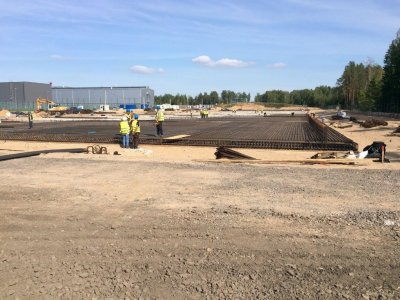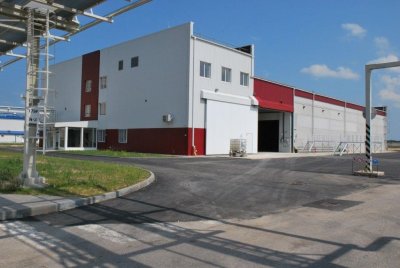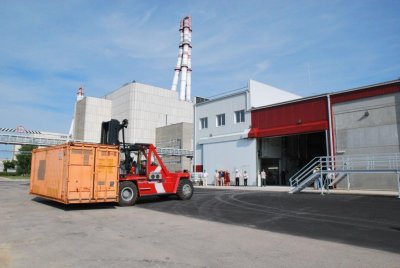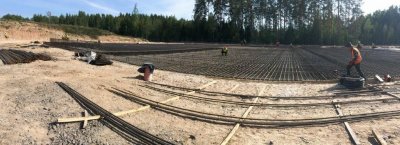B19 project. Landfill Facility for Very Low Level Radioactive Waste
General information about the Project
A purpose of B19 Project is to construct infrastructure for final disposal of very low level radioactive waste.
B19 Project consists of two sub-projects for construction two structures:
- Project B19-1 – Buffer Storage of 4000 m3 capacity. The Storage has been constructed on a territory of INPP and being operated since 2013;
- Project B19-2 – ,,Landfill“ type repository for placing 60000 m3 of very low level radioactive waste. The Landfill repository consists of three Disposal Modules of 20000 m3 each. Construction of the Modules has been started in 2017. Selection of Site, Feasibility evaluation, approval procedures, preparation of Design and Safety assessment Report have been carried out for Construction of the Landfill repository. The Landfill is being constructed near other decommissioning complexes of new INPP facilities for radioactive waste, such as Interim Spent Fuel Storage Facility (ISFSF - Project B1) and Solid Waste Management and Storage Facility (SWMSF - Project B3/4)
Buffer Storage – temporary, roofed, radioactive waste accumulating structure, that serves as interim Storage and occupies area of 0,2 ha. The Facility is equipped with a waste characterization unit and all other necessary means (software and hardware, handling and transportation equipment). After the Storage gets full of waste, Landfill disposal campaign will be organized. 15 campaigns are planned, each of disposal of 4000 m3 capacity packages with very low level radioactive waste
Waste Disposal Modules – ferroconcrete base-slab (foundation plate) with rainwater collection system installed, that serves as monitoring mean and controls water pollution every time before discharge, although Design foresees no exceeding of permittable limits of pollution. Main waste packages, that are planned to be disposed over the base-slab, are half-height ISO containers, plastic bales, flexible plastic containers (FIBC package). The packages will be placed on the stepped structure to form a roughly “hill shaped” stack, which will then be covered by layers of different natural and fabricated materials to achieve a smooth, hill-shaped form. Finally, hydro-isolation, drainage and protective layers will be laid on top to prevent water penetration into the waste stack and washout of radionuclides from the waste to the environment. Modules will occupy 4,4 ha area.
Landfills of this type have been already put into operation in Oskarshamn, Forsmark and Ringhals nuclear power plants in Sweden. The Swedish conceptual model of “Landfill” type repositories has been adapted during preparation of design solutions for INPP. INPP personnel, responsible for implementation of the Project and Landfill operation, took classes in aspects of Landfill repository construction and operation in Sweden.
Analogical purpose Repositories for final handling of very low level radioactive waste, however having certain structural specifics, had been constructed and are being operated in many European countries, such as France, Spain, UK and others. This way of handling is sustainable and does not burden future generation. Territory of repository will be suitable for unconditional use after certain period of waste disposal, because very low level radioactive waste is short-lived. 100 years of restrained usage of the territory has been determined and justified currently.
Progress of Project B19
Project implementation started on 29th December 2007.
Buffer Storage (B19-1)
Construction permission for Buffer Storage (B19-1) was given on 9th April 2010. Construction works systems installation had been completed in September 2011.
General data set for Buffer Storage was agreed with European Commission on 12th January 2011.
“Cold” testing of systems and complex Buffer Storage testing using waste packages imitators were performed in August 2011.
“Hot” tests Programme was agreed with VATESI on 4th January 2012.
“Hot” tests were performed on 25th – 27th April 2012.
On 16th July 2012 VATESI approved a report of complex ‘hot” tests of Biffare Storage and concluded, that the Storage meets Design requirements and requirements of nuclear, radiation and physical safety.
On 27th September 2012 State Committee of construction completion signed a Certificate of completion of construction of Buffer Storage.
INPP had been granted with Storage operation license by VATESI on 16th May 2013.
On 30th May 2013 INPP had been given a permission for industrial operation of the Storage.
Waste Disposal Modules
Construction of Project B19-2 base-slab (2019)
In August 2009 a Technical Design of Waste Disposal Modules and preliminary safety assessment report were agreed by INPP and the documents were sent for expertise to responsible institutions.
The special expertise of the Technical Design and preliminary safety assessment report were completed on 12th October 2010.
The Design was given for general expertise on 10th December 2010.
The general expertise was completed on 26th October 2011 and the design was submitted for approval to responsible institutions.
The technical Design of the Ladfill Repository was resubmitted for approval to responsible institutions because of variations of the Design and amendments of regulation of approval of designs of nuclear structures. The Technical design of Waste Disposal Modules was agreed with all responsible institutions on 23rd August 2013.
The Technical Design was adjusted during preparation and approval, because of changes of requirements for nuclear structures and conditions of connection of Repository facilities to existing engineering networks of INPP. Lithuanian State institutions approved the adjusted Design in August 2015.
Ministry of Environment issued a Permit for Repository construction on 4th November 2015. INPP prepared and sent to VATESI a set of documents, applying for license for Repository construction and operation.
VATESI license for Repository construction and operation was granted in December 2015
Construction Tender documents were prepared in 2015 – 2016 and agreed by CPVA in November 2016.
Tender took place in 2017.
Construction Contract, signed with Contractor on 22nd June 2017, came into force on 30th June 2017.
Repository general construction works have been performed in 2017 – 2019.
After completion of construction works in 2020 it is planned to perform construction completion procedures and start operation of the Landfill Repository.




